Manmade cellulose, derived from renewable sources, is gaining traction across industries due to its versatility. Produced through processes like viscose and lyocell, it finds applications in textiles, healthcare, automotive, and more. With growing demand for eco-friendly materials, traditional hubs and emerging regions are expanding production. Environmental concerns drive the adoption of sustainable practices, while technological advancements fuel innovation. As the market burgeons, stakeholders must collaborate to seize opportunities in manmade cellulose.
Manmade cellulose is primarily produced through the chemical processing of natural cellulose sources such as wood pulp, cotton lint, and other plant fibres. The two most common methods for manufacturing manmade cellulose are viscose and lyocell processes:
Viscose Process: This traditional method involves dissolving cellulose pulp in a solvent, often carbon disulfide, to create a viscous solution. The solution is then extruded through spinnerets to form fibres, which are further processed and treated to enhance their properties. Viscose fibres are widely used in textiles, hygiene products, and industrial applications.
Lyocell Process: In contrast to the viscose process, the lyocell method employs a solvent spinning technique that uses a non-toxic solvent, typically N-methyl morpholine N-oxide (NMMO). This environmentally friendly process results in fibres with exceptional strength, moisture absorption properties, and biodegradability. Lyocell fibres are commonly used in apparel, home textiles, and medical applications.
Manmade cellulose fibres are gaining market share in the textile industry, particularly in segments such as athleisure wear, activewear, and sustainable fashion. Manufacturers are increasingly incorporating these fibres into their product lines to meet the demand for eco-friendly and performance-enhancing materials. Beyond textiles, manmade cellulose is finding applications in diverse industries such as automotive, packaging, healthcare, and construction. The versatility of cellulose-based materials allows for innovation in product development, driving demand across multiple sectors.
While traditional manufacturing hubs like Indonesia, China, Singapore, Thailand, Germany, Japan, Taiwan, Malaysia, and India continue to dominate manmade cellulose production and export, other regions such as Southeast Asia and South America are emerging as key players in the global market. Investments in production facilities and technological advancements are facilitating the expansion of export capabilities in these regions.
Environmental concerns and regulatory pressures are prompting manufacturers to adopt sustainable practices in manmade cellulose production. This includes optimising resource usage, reducing emissions, and implementing closed-loop systems for solvent recovery and recycling.
The production and export of manmade cellulose are witnessing significant growth, driven by the demand for sustainable materials and innovative solutions across various industries. As technological advancements continue to improve manufacturing processes and expand the range of applications, manmade cellulose is poised to play a vital role in shaping the future of sustainable materials. By embracing sustainability initiatives and fostering collaboration across the value chain, stakeholders can capitalise on the opportunities the burgeoning market presents for manmade cellulose.
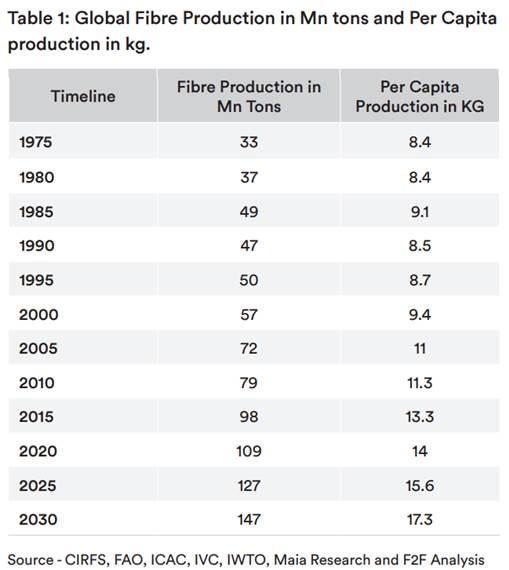


Global Fibre Production: A Timeline Analysis
Global fibre production has undergone significant evolution over the past decades, driven by technological advancements, shifting market demands, and sustainability considerations. This write-up presents a timeline analysis of manmade cellulose fibre production from 1975 to 2030, highlighting key milestones and trends.
1975-2000: Early Growth and Technological Advancements During this period, manmade fibre production experienced steady growth, primarily driven by the expansion of the textile industry and the adoption of synthetic fibres as alternatives to natural materials. Technological advancements, particularly in the viscose process, improved production efficiency and product quality, contributing to increased output.
1985 witnessed a notable milestone with fibre production reaching 49 million tons, reflecting the growing demand for fibres in textiles and other applications. Despite fluctuations in production levels in subsequent years, the overall trajectory remained upward, culminating in a production volume of 57 million tons by 2000.
The period between 2005 and 2020 marked a phase of accelerated growth and heightened focus on sustainability within the fibre industry. Increased consumer awareness regarding environmental issues and the adverse impacts of conventional fibre production processes led to the adoption of eco-friendly manufacturing practices.
By 2015, fibre production had nearly doubled from 2005 levels, reaching 98 million tons. This surge in production was driven by advancements in sustainable manufacturing technologies, such as the widespread adoption of the lyocell process, which offers superior environmental performance compared to traditional viscose production methods.
2020-2030: Looking ahead, the forecast for manmade cellulose fibre production remains optimistic, with projections indicating continued growth and market expansion. As sustainability continues to be a driving force in consumer preferences and industry practices, manufacturers are expected to invest further in eco-friendly production methods and innovative fibre technologies.
The evolution of fibre production has been characterised by continuous innovation, technological advancement, and a growing emphasis on sustainability. From modest beginnings in the 1970s to projected record-high production volumes in the coming decade, fibres have become indispensable components of the global materials landscape. As the industry navigates future challenges and opportunities, collaboration among stakeholders and ongoing investments in research and development will be crucial in shaping the next chapter of growth and sustainability in manmade cellulose fibre production.
Fibre Production by Type:

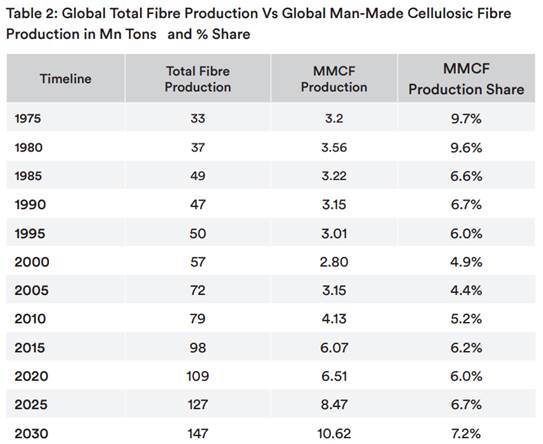
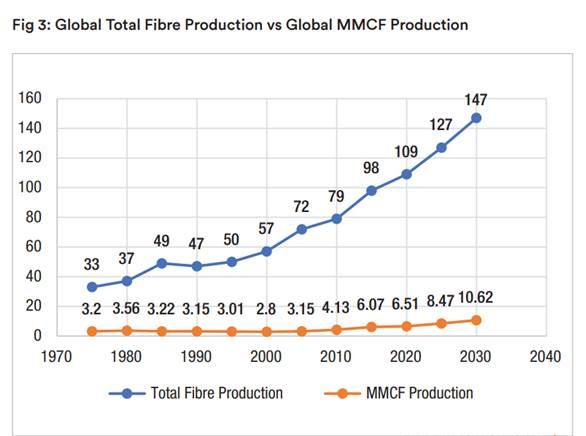
Evolution of Manmade Cellulose Fiber Production: A Comprehensive Analysis
The production of manmade cellulose fibres (MMCF) has experienced dynamic shifts over the past decades, influenced by factors such as technological advancements, market demands, and sustainability initiatives. This write-up provides a detailed analysis of the timeline of total fibre production and MMCF production, along with their respective shares, from 1975 to 2030, shedding light on the changing landscape of the fibre industry.
1975-2000: Early Growth and Relative Stability During this period, total fibre production witnessed steady growth, reflecting the expansion of the textile industry, and increasing demand for synthetic fibres. However, the share of MMCF production fluctuated within a relatively narrow range, hovering between 4.9 per cent and 9.7 per cent, indicating a stable but modest presence in the overall fibre market.
Technological advancements in the viscose process and the emergence of new MMCF production methods contributed to the gradual expansion of MMCF production capacity. Despite fluctuations in market share, MMCF remained a significant player in the fibre industry, particularly in segments requiring specific properties such as absorbency and comfort.
The period from 2005 to 2020 witnessed a notable increase in both total fibre production and MMCF production, driven by growing consumer awareness of environmental issues and the adoption of sustainable practices. As sustainability became a focal point, manufacturers invested in eco-friendly production methods and materials, including MMCF derived from renewable sources.
The share of MMCF production fluctuated within a narrow range during this period, peaking at 6.7 per cent in 2025. This increase reflects the growing recognition of MMCF as a sustainable alternative to conventional synthetic fibres, particularly in applications where environmental considerations are paramount.
2020-2030: Projected growth and market expansion. Looking ahead, the forecast for MMCF production remains optimistic, with projections indicating continued growth and an expanding market share. As sustainability concerns intensify and regulatory pressures mount, MMCF is poised to play an increasingly significant role in the fibre industry, displacing traditional synthetic fibres in various applications.
By 2030, MMCF production is projected to reach 10.62 million metric tons, with a corresponding market share of 7.2 per cent. This growth reflects sustained demand for eco-friendly fibres and the adoption of MMCF in new and diverse applications, including apparel, home textiles, and nonwoven products.
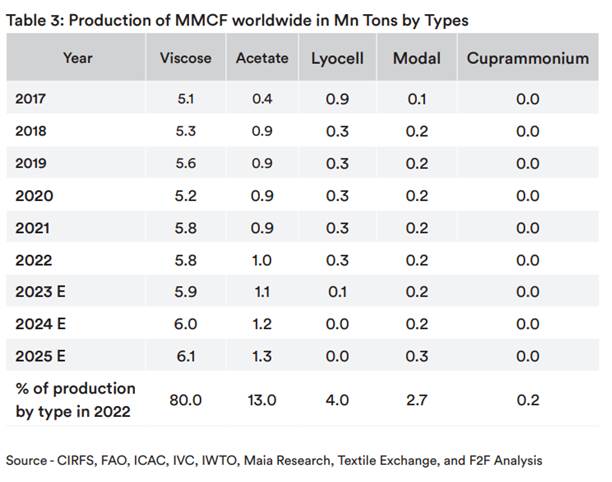
Table 3 above provides worldwide MMCF production information on the types and indicates the systematic growth of major components. Among the types of products, Viscose dominates as it corners 80 percent of the production portfolio.
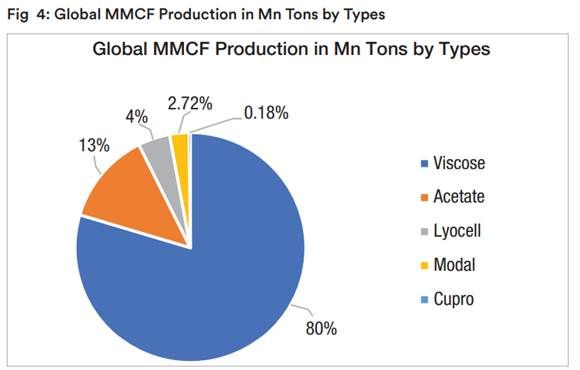
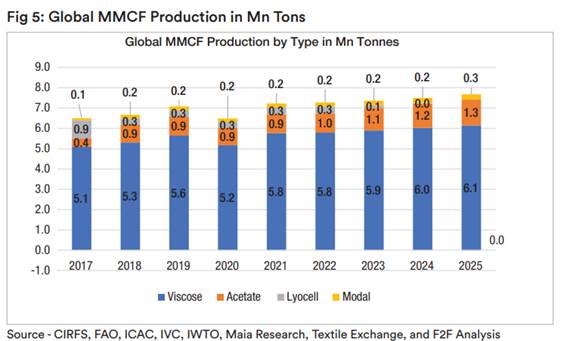
Conclusion
The evolution of MMCF production underscores the growing importance of sustainability and innovation in the fibre industry. From its modest beginnings to projected growth in the coming decade, MMCF has emerged as a key player in the quest for environmentally responsible materials. As stakeholders continue to invest in research and development and embrace sustainable practices, MMCF is poised to lead the transition towards a more sustainable and resilient future in the global fibre market.





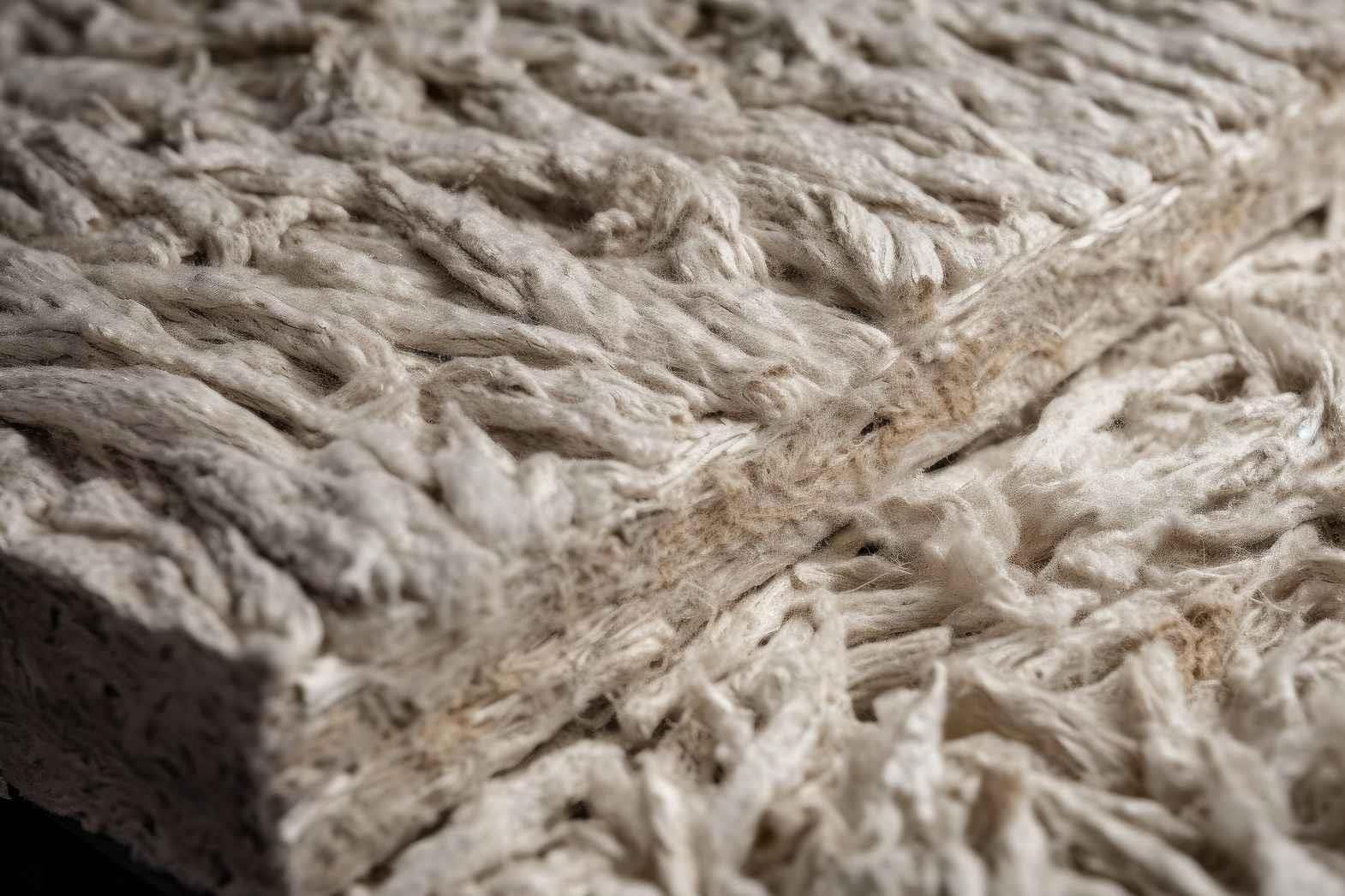





Comments